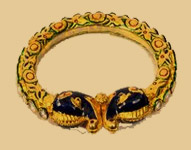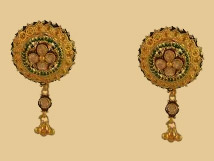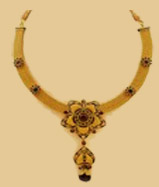MEENAKARI JEWELRY
In Meenakari Jewelry, precious stones are set and then enameled with gold. Historically speaking this ancient art was introduced to Rajasthan artisans by Raja Mansingh of Amer. He had invited Lahore-based skilled artisans to his kingdom, and their intermingling with the local craftsmen resulted in an amalgam, which came to be known as Meenakari. Meenakari is all about team work, where specialization of skill is of paramount importance. As it is generally done on the reverse side of kundan jewellery, meenakar has to work with goldsmith, engraver or ghaaria, designer or chitteria as well as jadiya.
The art requires higher skill and its intricacy calls for application of technical mindset. In Meenakari, the piece of metal on which the work is to be done, is fixed on a lac stick. Designs of flowers, birds, fish, etc., are engraved on it. This leads to the creation of walls or grooves to hold color. Enamel dust of required color is then poured into the grooves and each color is fired individually. The heat of the furnace melts the color and the colored liquid gets spread equally into the groove. This process is repeated with each color.
Subsequently, each color is individually fired. Colors, which are most heat resistant, are applied first, as they are re-fired with each additional color. Once the last color has been fired, the object is cooled and burnished or polished with agate. The depth of the grooves, filled with different colors, determines the play of light. Silver and gold are used for the base of Meenakari. Choice of colors, in case of silver, has to be green, yellow or blue, as these are the colors which stick with it. As for gold, all the colors can be applied to it and this is also the reason why the metal is preferred for Meenakari jewelry.

Meenakari art was a remarkable innovation of the Mughal in metal craft and can rightly be described as Moguls vision of Paradise on Earth. The art was popular among both the Moguls and the Princess of Rajasthan. The art formed an integral part of Indian jewelry as five skilled enamel workers were invited by Raja Man Singh of Jaipur. Meenakari is the art of colouring and embellishing the metal surface by fusing over it gleaming colors of intricate patterns.
Traditionally gold was used in Meenakari but in this present times silver is extensively used to bring luster and finesse in the ornament. The technique of this particular art entails perseverance and deliberation.

In Meenakari, an ornament is crafted in silver and then the artist draws the desired design. It is then outlined by the engraver to make the enamel adhere firmly to the metal. Enameller then brushes the ornament on the engraved design with special colors called Mina in red, green, black, yellow, blue, etc. A single piece of Mina pass through many bands before it reaches completion. A Minakari is truly nature captivated in silver.It is available in over 50 designs,in 19 different color combinations in precious and semi precious stones.
Meenakari work basically involves the decorating of the piece of metal or metal jewelry with vibrant enamel work and with a lac base in a myriad of colours and gorgeous designs.
Designs are engraved on the piece and the enamel is then brushed onto these engraved depressions in a fixed order depending on the colour of the enamel and how it lays and hardens. Designs with flowers, birds, animals and other delicate details are common. You will also find meenakari work accented with stones, beads and crystals resulting in some gorgeous pieces of jewelry in a rainbow of colours. Meenakari jewelry can be found in various colour schemes ranging from a single colour palette often used to match to a bridal trousseau or a mix of different colours, also depending on whether it is used on a gold or silver coloured base.


